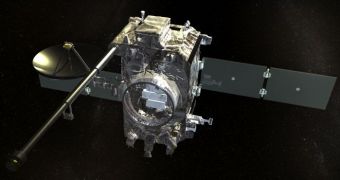One of the most successful missions NASA ever conducted, the Solar TErrestrial RElations Observatory (STEREO), has now turned 5. Both spacecraft making up this advanced system are in good health, and continue to carry out observations of the Sun from both sides of the planet.
STEREO consists of two identical spacecraft, both on the same orbit around the Sun that the Earth occupies. The first satellite flies ahead of our planet in orbit, while the second one trails behind. This provides the 3D, or stereo, view that the mission gets its name after.
At times, the distance between the two satellites is so great that they are literally located on opposing sides of the Sun, providing a view of the entire star at the same time. This is of great use for solar physicists seeking to keep track of ongoing solar phenomena such as flares and sunspots.
Other solar observatories are only capable of seeing one half of the Sun at any given point. While the resolution these observations have is very high, it cannot compensate for the fact that no one can realize what's coming from behind the solar horizon. With STEREO, this limitation disappeared.
The satellite also allow experts to measure a number of traits pertaining to various types of solar activity, something that has not been possible before. Because the two probes see in 3D, they can determine the size of a solar flare, and even measure its speed as it's approaching our planet.
“Over the last five years, each STEREO spacecraft has moved to a position in its orbit where it can capture side-view images of anything the sun Sends our way,” explains NASA Goddard Space Flight Center (GSFC) STEREO project scientist Joe Gurman.
“That's helped us come up with many new answers to old questions about solar activity,” the expert adds. The twin spacecraft launched aboard a Delta II delivery system on October 25, 2006, from the Cape Canaveral Air Force Station (CCAFS), in Florida.
Gurman explains that STEREO now allows solar physicists to determine when a solar flare or coronal mass ejection is pushing billions of tons of radiations and matter towards our planet. Such events can damage satellites and power grids, and endanger the lives of astronauts in space.
“The most important part of this configuration is not only does STEREO track CME visually from the Sun to Earth, but that information can be combined with data from several other spacecraft sitting right in the line of the solar activity,” GSFC STEREO deputy project scientist Therese Kucera adds.
“STEREO was designed to understand what causes CMEs and how they travel, as well as to understand the structure of the solar wind. It's already made great strides in doing that. I'm looking forward to the next five years,” Gurman concludes.

 14 DAY TRIAL //
14 DAY TRIAL //